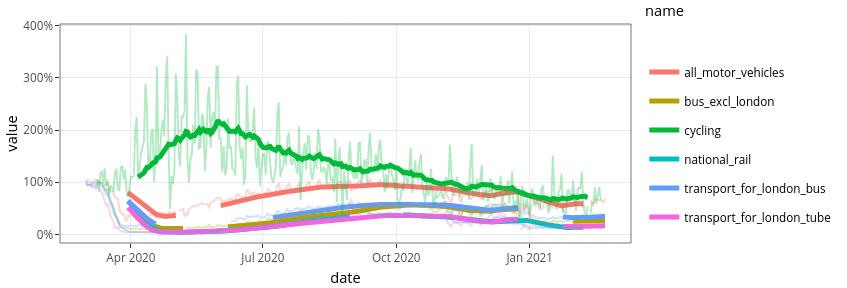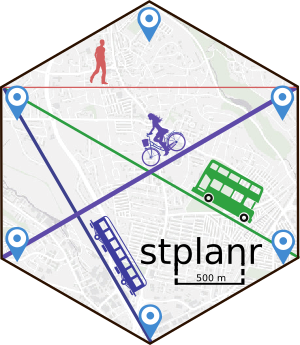Reproducible Geocomputation for Policy-Relevant Research and Tools
CASA, UCL, London
Robin Lovelace, University of Leeds
2022-07-13
Session plan
1 Introduction to my work and previous tools
Session plan
1 Introduction to my work and previous tools
2 New and emerging tools
Session plan
1 Introduction to my work and previous tools
2 New and emerging tools
3 Live demo and testing: ActDev
4 Coding and questions
- Beginner in R: install R and follow instructions at https://itsleeds.github.io/rrsrr/
- Intermediate level: work through the code in Chapter 13 of Geocomputation with R: https://geocompr.robinlovelace.net/transport.html
- Advanced: Add a new site in the ActDev tool: https://github.com/cyipt/actdev/blob/main/code/tests/add-new-site.md
We have 5 research groups
Working with TASM
Links with WYCA
Academic input
Sarah Sharples
Data can make a difference

Where I am now: PCT used by many in government
Too much data?
A nice problem to have?
Data historically a limiting factor
New approaches needed to tackle 'big noise'
Boyce, D.E., Williams, H.C.W.L., 2015. Forecasting Urban Travel: Past, Present and Future.
Too much data?
A nice problem to have?
Data historically a limiting factor
New approaches needed to tackle 'big noise'
Boyce, D.E., Williams, H.C.W.L., 2015. Forecasting Urban Travel: Past, Present and Future.

Lovelace, Robin, Mark Birkin, Philip Cross, and Martin Clarke. 2016. ‘From Big Noise to Big Data' https://doi.org/10.1111/gean.12081.
- For most of the history of transport planning data scarcity has been a major concern
- Now we have an abundance of datasets, many of them incompatible
- Concrete example: OD to WPZ data in central London (could ask if anyone knows, it's a mess hehe)
Problems worthy of your time
Problems worthy of your time
Ideas
Hackathons
Active travel
Road safety policy
Post COVID recovery
Levelling up metrics
Nature recovery networks
Citizen science and data literacy


Climate change: The elephant in the room
What is climate change? And how does it related to open source software?
It's great to be able to talk about climate change upfront. Usually it's behind the scenes.
To solve problems you need to talk about them.
Everyone including the elephant knows that climate change means the world is getting warmer.
But fewer people talk about 'global drying' and likely impacts such as sudden sea level rise that can only be described as catastrophic
As with health, the most solutions tackle the root causes of the problem. So what is the root cause of the problem? We can go back a few steps...
Climate change is caused by emissions.
Emissions are (primarily) caused by combustion of fossil fuels
But what causes that? Energy consumption.
What causes energy use? Demand for energy intensive things, transport, manufacturing
The Downward trend during coronavirus saw emissions drop by ~10%
The scale of the challenge is to reduce emissions by 10% every year, every year, and the challenge gets hard with each year
That means: we need transformational
Existing tools: The Propensity to Cycle Tool
- Early prototype of the tool developed at Open Data Institute Leeds hackathon, 2015
- National deployment of the Propensity to Cycle Tool 2 years later (PCT.bike) (Lovelace et al. 2017)

Key aspects of the PCT
- Based on open source code
- Based on open data
- Results published as open data
- Publicly available web application encourages participation and evidence-based debate
Open data and accessible results lead to participation. See https://twitter.com/search?q=cyipt.bike%2Frapid

Reproducibility and extending the tool
- Find commuting desire lines in West Yorkshire between 1 and 3 km long in which more people drive than cycle:

How it works

Existing tools: the Rapid Cycleway Prioritisation Tool
2 New and emerging tools



2 New and emerging tools



- Evidence-based policies in government: Data Science Fellowship at N. 10
- Turing Fellowship
- LIDA internship on open transport infrastructure data
- Links with DfT, MHCLG, TfNH, international partners
2 New and emerging tools



Evidence-based policies in government: Data Science Fellowship at N. 10
Future areas of development: Reproducible Bayesian modelling of proportions (Dirichlet regression), Machine Learning, Decarbonisation Agenda
- Turing Fellowship
- LIDA internship on open transport infrastructure data
- Links with DfT, MHCLG, TfNH, international partners
So what's the overall approach here?
3 Live demo and testing: ActDev
ActDev: a data driven tool for evidence-based planning
Interactive demo: https://actdev.cyipt.bike/
Talbot, Joseph, et al. 2021. ‘Active Travel Oriented Development: Assessing the Suitability of Sites for New Homes’. https://osf.io/7fuq5/
The ActDev project: https://actdev.cyipt.bike/

- A/B Street - R integration, see https://github.com/a-b-street/abstr
- Give it a try!
- Find a new housing development that has good active travel provision and potential
- How could active travel provision be made better?
- Find a housing development that has poor active travel provision
- How could active travel provision be improved, based on the data?
- Should new houses be built in this location?
- Find a new housing development that has good active travel provision and potential
Also complexity vs simplicity and readability
4 Coding and questions
- Beginner in R: install R and follow instructions at https://itsleeds.github.io/rrsrr/
- Intermediate level: work through the code in Chapter 13 of Geocomputation with R: https://geocompr.robinlovelace.net/transport.html
- Intermediate: demo of the {simodels} R package: https://github.com/Robinlovelace/simodels
- Advanced: Installation and use of the odjitter package: https://github.com/Robinlovelace/odjitter
- Advanced: Add a new site in the ActDev tool: https://github.com/cyipt/actdev/blob/main/code/tests/add-new-site.md
Thanks!
Thanks!
References
Thanks!
References
Lovelace, R., Goodman, A., Aldred, R., Berkoff, N., Abbas, A., Woodcock, J., 2017. The Propensity to Cycle Tool: An open source online system for sustainable transport planning. Journal of Transport and Land Use 10. https://doi.org/10.5198/jtlu.2016.862
Thanks!
References
Lovelace, R., Goodman, A., Aldred, R., Berkoff, N., Abbas, A., Woodcock, J., 2017. The Propensity to Cycle Tool: An open source online system for sustainable transport planning. Journal of Transport and Land Use 10. https://doi.org/10.5198/jtlu.2016.862
Morgan, M., Lovelace, R., 2020. Travel flow aggregation: nationally scalable methods for interactive and online visualisation of transport behaviour at the road network level. Environment & Planning B: Planning & Design. https://doi.org/10.1177/2399808320942779
Thanks!
References
Lovelace, R., Goodman, A., Aldred, R., Berkoff, N., Abbas, A., Woodcock, J., 2017. The Propensity to Cycle Tool: An open source online system for sustainable transport planning. Journal of Transport and Land Use 10. https://doi.org/10.5198/jtlu.2016.862
Morgan, M., Lovelace, R., 2020. Travel flow aggregation: nationally scalable methods for interactive and online visualisation of transport behaviour at the road network level. Environment & Planning B: Planning & Design. https://doi.org/10.1177/2399808320942779
Lovelace, R., Tennekes, M., Carlino, D., 2021. ClockBoard: a zoning system for urban analysis. https://doi.org/10.31219/osf.io/vncgw
Thanks!
References
Lovelace, R., Goodman, A., Aldred, R., Berkoff, N., Abbas, A., Woodcock, J., 2017. The Propensity to Cycle Tool: An open source online system for sustainable transport planning. Journal of Transport and Land Use 10. https://doi.org/10.5198/jtlu.2016.862
Morgan, M., Lovelace, R., 2020. Travel flow aggregation: nationally scalable methods for interactive and online visualisation of transport behaviour at the road network level. Environment & Planning B: Planning & Design. https://doi.org/10.1177/2399808320942779
Lovelace, R., Tennekes, M., Carlino, D., 2021. ClockBoard: a zoning system for urban analysis. https://doi.org/10.31219/osf.io/vncgw
Lovelace, Robin, Rosa Félix, and Dustin Carlino. “Jittering: A Computationally Efficient Method for Generating Realistic Route Networks from Origin-Destination Data.” OSF Preprints, January 13, 2022. https://doi.org/10.31219/osf.io/qux6g.



 Source: Morgan and Lovelace (
Source: Morgan and Lovelace (

 Source: Lovelace, Tennekes, Carlino (
Source: Lovelace, Tennekes, Carlino (